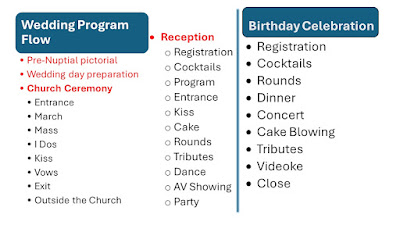Three weeks ago, I attended a millennial wedding, the 2nd one in two decades. I experienced how it was to witness a Catholic ceremony and a reception managed by an events’ group. So different from how generations X conduct theirs.
The ceremony before, during, and after is thoroughly documented. The reception is organized around a program, with food and beverages given as needed. A module was put up for the bride and groom before concluding with a same-day video editing demonstration.
A week ago, I attended a birthday party at a restaurant bar with a stage for live musical performances. This one, like the wedding, appeared to have an event organizer. Confirmation of an invitation was requested weeks ago.
At the gate, guests were asked to show their invitation and confirmation. Seating was allotted. The highlight was a mini concert by a well-known vocalist campaigning for no cover songs, just original live singing, accompanied by two singers and five musicians. Every now and again, the solo performer includes information about the celebrant, adding a personal and intimate touch.
Food and beverages were served during the performance. The entire party was thoroughly captured by a photographer and videographer. Android phones were in a tripod to cover activities on and off stage.
Following the concert, the stage was open for any guests to sing till early morning.
Reflecting on the current wedding and birthday festivities I attended, I can't help but be amazed at how much has changed since the 1970s and 1980s. Back then, our celebrations were basic, generally hosted in our homes or offices, with homemade décor and family-prepared food. Guests bring in bottles of hard liquor for consumption. Today's events combine creativity, technology, and professional touches to create experiences that are both personal and grand.The satisfaction was undoubtedly different.
What struck me most was the attention to detail and the desire to make each celebration unique. From personalized vows and custom playlists to interactive photo booths and gourmet catering, every element was thoughtfully chosen to reflect the personalities and stories of those being celebrated. These modern celebrations honor our traditions while also embracing new ways of bringing people together.
The infrastructure set up was provided for the comfort and pleasure of the guests taking away the burden of preparation from the celebrants. The center remains to be the interaction and socialization of the guests; while dining, memories were recalled, anecdotes shared, and significance of the activity highlighted fully credited to the hosts.
As I watched the joy and connection among the guests, I realized that while the methods and styles of celebration have evolved, the heart of these events remains the same. It's still about coming together, sharing joy, and creating memories with loved ones.
Witnessing this blend of old and new filled me with a sense of nostalgia and excitement for the future, wondering how we will continue to innovate and celebrate life's special moments in even more meaningful ways.Both events ended with thanks with a twist. Thanking the guests for witnessing the moments with them, acknowledgement were also given to the sponsors and suppliers
Best wishes to the couple. Happy birthday to the celebrants. These greetings have not changed.


